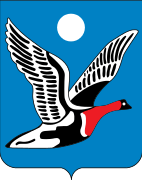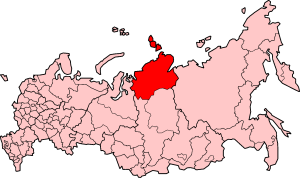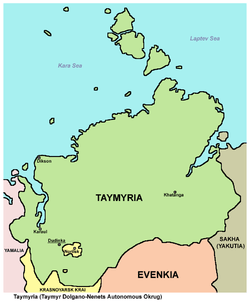Taymyr Autonomous Okrug
Taymyr Dolgano-Nenets Autonomous Okrug (Russian: Таймы́рский Долга́но-Не́нецкий автоно́мный о́круг, Taymyrsky Dolgano-Nenetsky avtonomny okrug), or Taymyria (Таймырия, Taymyriya), was a federal subject of Russia (an autonomous okrug of Krasnoyarsk Krai), the northernmost in mainland Russia (and thus Asia). It was named after the Taymyr Peninsula. It was also called Dolgan-Nenets Autonomous Okrug (Долгано-Ненецкий автономный округ), by the name of the indigenous people, Dolgans and Nenetses.
Taymyr Autonomous Okrug | |
|---|---|
| Таймырский Aвтоно́мный Oкруг | |
 Coat of arms | |
 | |
| Country | Russia |
| Federal district | Siberian[1] |
| Economic region | East Siberian[2] |
| Established | 10 December 1930 |
| Capital | Dudinka |
| Government | |
| • Body | Duma |
| • Last Governor | Oleg Budargin |
| Area | |
| • Total | 879,929 km2 (339,742 sq mi) |
| Area rank | 7th |
| Population | |
| • Estimate (2007) | 38,372 |
| Time zone | UTC+7 (MSK+4 |
| Official languages | Russian[5] |

With an area of 862,100 km² (ranked 4th) and a population of 39,786 (2002 Census), the autonomous okrug was one of the least densely populated areas of Russia as of 2006. Dudinka, with more than half of Taymyria's inhabitants, was the administrative center.
Following a referendum on the issue held on April 17, 2005, Taymyr Dolgano-Nenets and Evenk Autonomous Okrugs were merged into Krasnoyarsk Krai effective January 1, 2007. Taymyria was given a special status within Krasnoyarsk Krai and incorporated as Taymyrsky Dolgano-Nenetsky District.
Administrative divisions

.jpg)
The city of Norilsk, even though it is geographically located within Taymyr Autonomous Okrug, was administratively subordinated directly to Krasnoyarsk Krai prior to the merger. This also applied to the urban-type settlement of Snezhnogorsk, which was administratively subordinated to Norilsk. Therefore, the okrug's population reported by the Census authorities does not include the populations of Norilsk and Snezhnogorsk.
In popular culture
Although not actually having been filmed in Taymyr, it is depicted in the 1985 film White Nights, starring Mikhail Baryshnikov and Gregory Hines. During the opening moments of the film, Baryshnikov's character Nikolai Rodchenko - a Soviet defector - is on a passenger plane that crash lands at "Norilsk Air Base." He inevitably is taken into the home of Hines' character - a US defector - and his wife (played by Isabella Rossellini), where they advise him that he is in Taymyr upon regaining consciousness.
Demographics
Population
(2002): 39,786.
Vital statistics
| Average population (x 1000) | Live births | Deaths | Natural change | Crude birth rate (per 1000) | Crude death rate (per 1000) | Natural change (per 1000) | |
|---|---|---|---|---|---|---|---|
| 1970 | 38 | 761 | 299 | 462 | 20.0 | 7.9 | 12.2 |
| 1975 | 42 | 857 | 317 | 540 | 20.4 | 7.5 | 12.9 |
| 1980 | 46 | 996 | 333 | 663 | 21.7 | 7.2 | 14.4 |
| 1985 | 51 | 1 104 | 370 | 734 | 21.6 | 7.3 | 14.4 |
| 1990 | 51 | 842 | 360 | 482 | 16.4 | 7.0 | 9.4 |
| 1991 | 50 | 789 | 335 | 454 | 15.8 | 6.7 | 9.1 |
| 1992 | 48 | 692 | 401 | 291 | 14.4 | 8.3 | 6.0 |
| 1993 | 46 | 617 | 448 | 169 | 13.4 | 9.7 | 3.7 |
| 1994 | 44 | 585 | 518 | 67 | 13.3 | 11.8 | 1.5 |
| 1995 | 43 | 537 | 501 | 36 | 12.6 | 11.8 | 0.8 |
| 1996 | 42 | 486 | 441 | 45 | 11.7 | 10.6 | 1.1 |
| 1997 | 41 | 483 | 374 | 109 | 11.9 | 9.2 | 2.7 |
| 1998 | 40 | 498 | 368 | 130 | 12.6 | 9.3 | 3.3 |
| 1999 | 39 | 448 | 376 | 72 | 11.6 | 9.7 | 1.9 |
| 2000 | 38 | 460 | 438 | 22 | 12.0 | 11.4 | 0.6 |
| 2001 | 39 | 562 | 438 | 124 | 14.5 | 11.3 | 3.2 |
| 2002 | 39 | 608 | 397 | 211 | 15.5 | 10.1 | 5.4 |
| 2003 | 39 | 625 | 386 | 239 | 15.9 | 9.8 | 6.1 |
| 2004 | 39 | 637 | 345 | 292 | 16.5 | 8.9 | 7.6 |
| 2005 | 38 | 548 | 369 | 179 | 14.5 | 9.7 | 4.7 |
| 2006 | 37 | 540 | 347 | 193 | 14.5 | 9.3 | 5.2 |
Ethnic groups
Of the 39,786 residents (as of the 2002 census) 1,018 (2.6%) chose not to specify their ethnic background. A quarter of the population identified themselves as indigenous Siberians (Dolgans, Nenets, Nganasans, Evenks, or Enets). 58.6% of the population were ethnic Russians. Other nationalities included 2,423 Ukrainians (6.1%), 587 Volga Germans (1.5%), 425 Volga Tatars (1.1%), 294 Belarusians (0.7%) and 239 Azeris (0.6%)
| Ethnic group |
1939 Census | 1959 Census | 1970 Census | 1979 Census | 1989 Census | 2002 Census | 2010 Census | |||||||
|---|---|---|---|---|---|---|---|---|---|---|---|---|---|---|
| Number | % | Number | % | Number | % | Number | % | Number | % | Number | % | Number | % | |
| Dolgans1 | 3,971 | 13.8% | 3,934 | 11.8% | 4,344 | 11.4% | 4,338 | 9.7% | 4,939 | 8.9% | 5,517 | 13.9% | ||
| Nenets | 2,523 | 8.8% | 1,878 | 5.6% | 2,247 | 5.9% | 2,345 | 5.2% | 2,446 | 4.4% | 3,054 | 7.7% | ||
| Enets2 | 103 | 0.2% | 197 | 0.5% | ||||||||||
| Nganasans3 | 682 | 2.0% | 765 | 2.0% | 746 | 1.7% | 849 | 1.5% | 766 | 1.9% | ||||
| Evenks | 563 | 2.0% | 412 | 1.2% | 413 | 1.1% | 338 | 0.8% | 311 | 0.6% | 305 | 0.8% | ||
| Russians | 16,931 | 59.0% | 21,799 | 65.3% | 25,465 | 66.9% | 30,640 | 68.2% | 37,438 | 67.1% | 23,348 | 58.6% | ||
| Others | 4,723 | 16.5% | 4,677 | 14.0% | 4,826 | 12.7% | 6,546 | 14.6% | 9,717 | 17.4% | 6,629 | 16.7% | ||
| Notes: | ||||||||||||||
- Президент Российской Федерации. Указ №849 от 13 мая 2000 г. «О полномочном представителе Президента Российской Федерации в федеральном округе». Вступил в силу 13 мая 2000 г. Опубликован: "Собрание законодательства РФ", No. 20, ст. 2112, 15 мая 2000 г. (President of the Russian Federation. Decree #849 of May 13, 2000 On the Plenipotentiary Representative of the President of the Russian Federation in a Federal District. Effective as of May 13, 2000.).
- Госстандарт Российской Федерации. №ОК 024-95 27 декабря 1995 г. «Общероссийский классификатор экономических регионов. 2. Экономические районы», в ред. Изменения №5/2001 ОКЭР. (Gosstandart of the Russian Federation. #OK 024-95 December 27, 1995 Russian Classification of Economic Regions. 2. Economic Regions, as amended by the Amendment #5/2001 OKER. ).
- Федеральная служба государственной статистики (Federal State Statistics Service) (2004-05-21). "Территория, число районов, населённых пунктов и сельских администраций по субъектам Российской Федерации (Territory, Number of Districts, Inhabited Localities, and Rural Administration by Federal Subjects of the Russian Federation)". Всероссийская перепись населения 2002 года (All-Russia Population Census of 2002) (in Russian). Federal State Statistics Service. Retrieved 2011-11-01.
- "Об исчислении времени". Официальный интернет-портал правовой информации (in Russian). 3 June 2011. Retrieved 19 January 2019.
- Official throughout the Russian Federation according to Article 68.1 of the Constitution of Russia.
